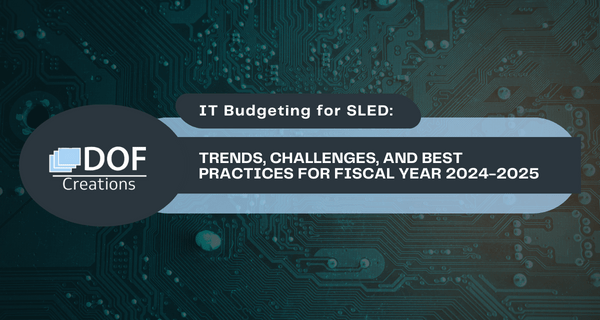As we step into the fiscal year (FY) 2024-2025, State, Local, and Education (SLED) entities are at the precipice of significant transformation. Technology has never been more central to their operations, policy-making, and service delivery. This blog post will delve into the trends, challenges, and best practices that SLED entities are considering as they plan their IT budgets for the upcoming fiscal year.
IT Budgeting Trends
Increased Investment in Digital Transformation
In the wake of the COVID-19 pandemic, digital transformation has shifted from a long-term goal to an immediate necessity for many SLED entities. As such, we can expect to see increased budget allocations for initiatives that facilitate remote work, improve online service delivery, and bolster digital infrastructure.
Cybersecurity Takes Center Stage
The rise of cyber threats has underscored the need for robust cybersecurity measures. SLED entities are likely to allocate a larger portion of their IT budgets to cybersecurity solutions, including advanced threat detection systems, security operations center (SOC) services, and cybersecurity training for employees.
Emphasis on Data Privacy and Compliance
As SLED entities handle vast amounts of sensitive data, protecting this data and ensuring regulatory compliance is paramount. Therefore, investments in data privacy tools and compliance software are expected to feature prominently in IT budgets.
Challenges in IT Budgeting
Balancing Priorities Amid Fiscal Constraints
One of the key challenges SLED entities face is balancing their IT priorities within limited budget constraints. While the need for investment in areas like cybersecurity and digital transformation is evident, finding the funds to support these initiatives can be challenging.
Keeping Pace with Rapid Technological Change
The pace of technological change presents another significant challenge. Emerging technologies, such as AI, IoT, and blockchain, offer promising benefits but also require new investments and skills. SLED entities must strategically plan their IT budgets to incorporate these technologies without sacrificing their current operational needs.
Best Practices for IT Budgeting
Align IT Spending with Strategic Goals
IT budgeting should not be done in isolation. Instead, IT spending should align with the strategic goals of the organization. By linking IT investments to organizational objectives, SLED entities can ensure that their IT spending is focused on initiatives that provide the most value.
Foster Collaboration Between IT and Business Units
Successful IT budgeting requires collaboration between IT and business units. This collaboration ensures that IT investments are aligned with business needs and that IT initiatives are understood and supported by all stakeholders.
Plan for the Unexpected
Given the unpredictability of today’s technological landscape, it’s essential for SLED entities to plan for the unexpected. This could involve setting aside a portion of the IT budget for unexpected costs or investing in solutions that provide flexibility and scalability.
Looking Ahead: FY 2024-2025
Looking ahead to FY 2024-2025, SLED entities are likely to face a landscape of both exciting opportunities and daunting challenges. Digital transformation, cybersecurity, and data privacy will continue to be key focus areas. Balancing these priorities amid fiscal constraints and rapid technological change will require strategic planning, collaboration, and flexibility. However, by aligning IT spending with strategic goals, fostering collaboration, and planning for the unexpected, SLED entities can position themselves to make the most of their IT budgets in the coming fiscal year. Get in touch with us at DOF creations today for an evaluation and consultation of your fiscal plans for 2024-2025.



